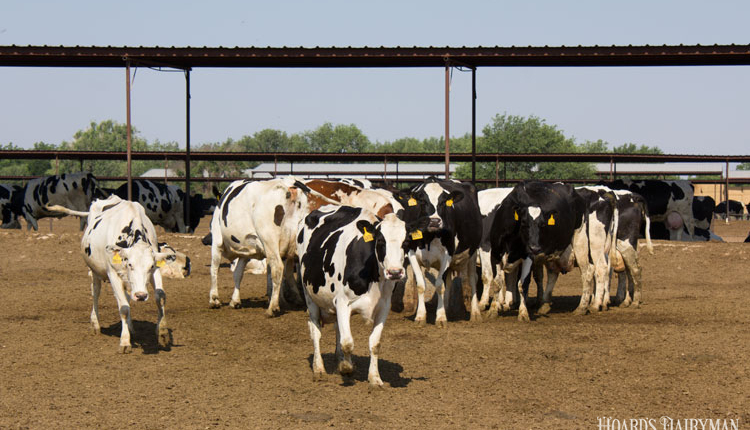The author is a professor and extension dairy specialist with Texas AgriLife Extension Service, Texas A&M University system.
Research papers focused on heifer-specific reproductive issues were presented at the 103rd annual meeting of the American Dairy Science Association in Montreal, Quebec, Canada. In this review, we will look at sexed semen performance, both conception and postcalving. What follows is a summary of the studies, comments, and author contact.
Sexed semen conception rates
Breeding information from approximately 1.25 million virgin Holstein heifers and 10.6 million Holstein cows was collected from 2006 to 2008 to characterize sexed semen usage. In addition, changes in fertility that should be expected when using sexed semen were quantified. Only 9.3 percent of heifer and just 0.23 percent of all cow inseminations were with sexed semen.
The average conception rate fell from 57 to 43 percent in heifers and from 31 to 27 percent in cows when sexed semen was used. Conception rates declined with increasing service number for both heifers and cows. The declines were similar between conventional and sexed semen. Of all sexed semen inseminations for heifers, 82 percent were on first service with an additional 14 percent on second service. For cows, 72 percent of all sexed semen inseminations occurred during the first two services in first- or second-lactation cows.
Comment: There has been greater sexed semen usage from 2006 through 2008. The drop in conception rate observed in heifers in initial studies was similar to that reported with this much larger database. Although industry recommendations are to only use sexed semen on heifers, there has been selective use in the lactating herd. The drop in conception rate for lactating cows with sexed semen was less than that reported in heifers. Due to lower conception rates, producers are encouraged to use sexed semen in the most fertile animals.
Contact author: H. D. Norman, Animal Improvement Programs Laboratory, Beltsville, Md.; phone: (301) 504-8334; e-mail: duane.norman@ars.usda.gov
Postpartum performance with sexed semen
The objectives of this trial were to determine whether virgin heifers bred with sexed semen at first insemination had differences in calving ease, calf sex, incidence of early lactation disorders, subsequent reproductive disorders, or milk production during the first lactation. The study was conducted in two herds with 343 heifers receiving first insemination with sexed semen. Conventional semen was used for 1,028 heifers.
As would be expected, fewer heifers conceived at first service with the sexed semen compared to the conventional semen; however, there were no differences in subsequent pregnancy losses. There were 85.7 percent female calves from the heifers bred with sexed semen and 47.7 percent female calves with conventional semen. There was a tendency (P<0.09) for heifers bred with conventional semen to have more dystocia when they delivered bull calves. Heifers bred with sexed semen were more likely to have stillborn calves. The incidence of early lactation disease and first-lactation reproduction and milk production were not impacted by using sexed semen. Heifers bred with sexed semen had higher rearing costs and greater income from calves; however, there was no difference in milk production, income over feed cost, replacement cost, or overall return.
Comment: Although more heifer calves were born to heifers bred with sexed semen, there were no differences in the incidence of disorders in early lactation or subsequent reproduction and production. That means greater costs associated with sexed semen must be recovered from the additional value of the heifer calves or from reducing the disease risk associated with introducing purchased heifers when expanding. There may also be additional value associated with genetic improvement if sexed semen is used for obtaining replacement heifers only from the top females in a herd.
Contact: Ricardo Chebel, University of Minnesota; phone: (612) 625-3130; e-mail: chebe002@umn.edu
Click here to return to the Reproduction E-Sources
100410_264
Research papers focused on heifer-specific reproductive issues were presented at the 103rd annual meeting of the American Dairy Science Association in Montreal, Quebec, Canada. In this review, we will look at sexed semen performance, both conception and postcalving. What follows is a summary of the studies, comments, and author contact.
Sexed semen conception rates
Breeding information from approximately 1.25 million virgin Holstein heifers and 10.6 million Holstein cows was collected from 2006 to 2008 to characterize sexed semen usage. In addition, changes in fertility that should be expected when using sexed semen were quantified. Only 9.3 percent of heifer and just 0.23 percent of all cow inseminations were with sexed semen.
The average conception rate fell from 57 to 43 percent in heifers and from 31 to 27 percent in cows when sexed semen was used. Conception rates declined with increasing service number for both heifers and cows. The declines were similar between conventional and sexed semen. Of all sexed semen inseminations for heifers, 82 percent were on first service with an additional 14 percent on second service. For cows, 72 percent of all sexed semen inseminations occurred during the first two services in first- or second-lactation cows.
Comment: There has been greater sexed semen usage from 2006 through 2008. The drop in conception rate observed in heifers in initial studies was similar to that reported with this much larger database. Although industry recommendations are to only use sexed semen on heifers, there has been selective use in the lactating herd. The drop in conception rate for lactating cows with sexed semen was less than that reported in heifers. Due to lower conception rates, producers are encouraged to use sexed semen in the most fertile animals.
Contact author: H. D. Norman, Animal Improvement Programs Laboratory, Beltsville, Md.; phone: (301) 504-8334; e-mail: duane.norman@ars.usda.gov
Postpartum performance with sexed semen
The objectives of this trial were to determine whether virgin heifers bred with sexed semen at first insemination had differences in calving ease, calf sex, incidence of early lactation disorders, subsequent reproductive disorders, or milk production during the first lactation. The study was conducted in two herds with 343 heifers receiving first insemination with sexed semen. Conventional semen was used for 1,028 heifers.
As would be expected, fewer heifers conceived at first service with the sexed semen compared to the conventional semen; however, there were no differences in subsequent pregnancy losses. There were 85.7 percent female calves from the heifers bred with sexed semen and 47.7 percent female calves with conventional semen. There was a tendency (P<0.09) for heifers bred with conventional semen to have more dystocia when they delivered bull calves. Heifers bred with sexed semen were more likely to have stillborn calves. The incidence of early lactation disease and first-lactation reproduction and milk production were not impacted by using sexed semen. Heifers bred with sexed semen had higher rearing costs and greater income from calves; however, there was no difference in milk production, income over feed cost, replacement cost, or overall return.
Comment: Although more heifer calves were born to heifers bred with sexed semen, there were no differences in the incidence of disorders in early lactation or subsequent reproduction and production. That means greater costs associated with sexed semen must be recovered from the additional value of the heifer calves or from reducing the disease risk associated with introducing purchased heifers when expanding. There may also be additional value associated with genetic improvement if sexed semen is used for obtaining replacement heifers only from the top females in a herd.
Contact: Ricardo Chebel, University of Minnesota; phone: (612) 625-3130; e-mail: chebe002@umn.edu
100410_264











